Engineering the ultrathin polyamide nanofilm featuring high free volume via interfacial polymerization for efficient CO2 capture
IF 8.4
1区 工程技术
Q1 ENGINEERING, CHEMICAL
引用次数: 0
Abstract
Interfacial polymerization (IP) has been received as an indispensable technology to fabricate thin-film composite (TFC) membranes for gas separation because of the simple and designable process. However, achieving the highly permeable polyamide (PA) TFC membrane for CO2 capture via the IP technique remains challenging. Herein, a highly CO2-permeable PA TFC membrane was synthesized by the polycondensation of N, N-Bis [3-(methylamino) propyl]methylamine (BMAPAm) and trimesoyl chloride (TMC). The ultrathin (∼47 nm) PA TFC membrane featuring with high free volume exhibited excellent CO2 permeance with moderate CO2/N2 selectivity. The causes of this desired structure were systematically investigated from the aspects of monomer supply and molecular structure, in which the 3,3′-diamino-N-methyldipropylamine (DNMDAm) was used as a comparison. The results illustrated the underlying monomer-structure-performance relationships of IP-made membranes, demonstrating the solid potential of the IP technology specifically toward high-performance CO2 capture membranes. Finally, a pilot-scale continuous membrane fabrication process was demonstrated.

通过界面聚合技术制造具有高自由体积的超薄聚酰胺纳米薄膜,用于高效捕获二氧化碳
界面聚合(IP)因其工艺简单、可设计性强,已被视为制造气体分离薄膜复合(TFC)膜不可或缺的技术。然而,通过 IP 技术实现用于二氧化碳捕集的高渗透性聚酰胺(PA)TFC 膜仍然具有挑战性。本文通过 N,N-双[3-(甲基氨基)丙基]甲胺(BMAPAm)和三甲基甲酰氯(TMC)的缩聚合成了高二氧化碳渗透性聚酰胺 TFC 膜。具有高自由体积的超薄(∼47 nm)PA TFC 膜表现出优异的 CO2 渗透性和适度的 CO2/N2 选择性。研究人员以 3,3′-二氨基-N-甲基二丙胺(DNMDAm)为比较对象,从单体供应和分子结构两方面系统地研究了这种理想结构的成因。结果表明了 IP 制造膜的基本单体-结构-性能关系,证明了 IP 技术在高性能二氧化碳捕集膜方面的巨大潜力。最后,还展示了中试规模的连续膜制造工艺。
本文章由计算机程序翻译,如有差异,请以英文原文为准。
求助全文
约1分钟内获得全文
求助全文
来源期刊

Journal of Membrane Science
工程技术-高分子科学
CiteScore
17.10
自引率
17.90%
发文量
1031
审稿时长
2.5 months
期刊介绍:
The Journal of Membrane Science is a publication that focuses on membrane systems and is aimed at academic and industrial chemists, chemical engineers, materials scientists, and membranologists. It publishes original research and reviews on various aspects of membrane transport, membrane formation/structure, fouling, module/process design, and processes/applications. The journal primarily focuses on the structure, function, and performance of non-biological membranes but also includes papers that relate to biological membranes. The Journal of Membrane Science publishes Full Text Papers, State-of-the-Art Reviews, Letters to the Editor, and Perspectives.
 求助内容:
求助内容: 应助结果提醒方式:
应助结果提醒方式:


